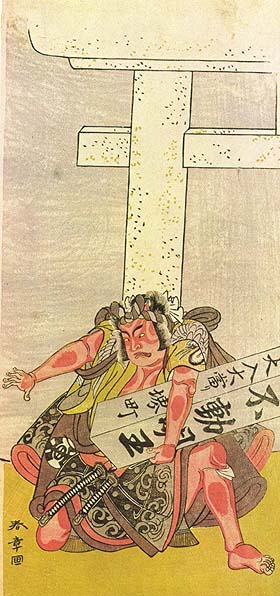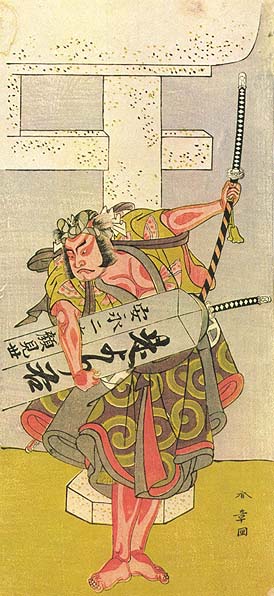| GOHIIKI KANJINCHď |
| Play title | Gohiiki Kanjinch˘ Great Favorite Subscription List* |
| Authors | Sakurada Jisuke I Kawatake Shinshichi I Okuno Sasuke |
| History |
Sakurada Jisuke I's lavish kaomise drama "Gohiiki Kanjinch˘" was premiered in the 11th lunar month of 1773 in Edo at the Nakamuraza [casting]. It celebrated the shűmei of Nakamura Rik˘ I. This 46-days long performance started the 1st day of the 11th lunar month of 1773, which was the 14th of December 1773 in the western calendar. This kaomise program was a huge success. |
| Structure |
The original drama was in 6 acts. The current version is made up of 3 acts. |
| Key words |
Aragoto Echizen Fujiwara Hidehira Fujiwara Takahira Genpei Kassen Genpei-kassenmono Genji Horikawa Imo Arai Iwashimizu Hachimangű Jidaimono Kaga Kajiwara Kagetoki Kanjinch˘ Kaomise Kiyomoto Kumadori Mie Minamoto Yoshitsune Motoyoshi Shir˘ Musashib˘ Benkei Nagauta ďshű ďzatsuma Tachimawari Yamabushi Yamashiro Yoshitsune Shitenn˘ |
| Summary |
Act I: at the Iwashimizu Hachiman Shrine in the Province of Yamashiro The play is set at the end of the 12th century. The emperor's brother, Koreaki, is plotting to usurp power following the defeat of the Heike clan. He attacks Yoshitsune's mansion at Horikawa in Ky˘to and, in the confusion, he makes off with a precious sword that Yoshitsune had been guarding since his return from the Western Sea. The loss of the sword arouses the suspicions of Yoritomo, the leader of the Genji clan, in Kamakura. Further, lying rumours are spread by the traitor Kajiwara Kagetoki and Yoshitsune is forced to flee from Ky˘to leaving behind his wife, Princess Iwate. A search warrant is immediately sent out from Kamakura for his arrest, and barriers are set up throughout the five provinces around Ky˘to and on all main roads going beyond. Shimokawabe Yukihira, in his position as Magistrate, arrives in Ky˘to and comes to pay his respects at the Hachiman Shrine. Yukihira is followed by Togashi Saemon's sister Princess Murasame. Yukihira secretly sympathizes with Yoshitsune and since Princess Murasame's brother, Togashi is guarding the barrier at Ataka on the road to the North, Yukihira promises to marry Princess Murasame. By doing this, he hopes that Togashi will allow Yoshitsune to pass through the barrier. However, at this moment, Koreaki arrives and realizes what Yukihira is planning. He orders the nyűd˘ Inage Shigenari to arrest them for immoral behaviour. Things seem to be going well for Koreaki, as he, himself, is harbouring an illicit passion for Yoshitsune's wife Princess Iwate. He has her brought forward and advises her to comply with his desires. She refuses. Koreaki, in a fury, orders the immediate execution of all three of them. Just as the sword is being raised, a great voice is heard shouting (Wait! ' (Shibaraku! ). It is Yoshitsune's faithful follower and right hand man, Kumai no Tar˘ Tadamoto who has come to stop the execution. The sight of Koreaki arrayed in all his power and glory does not dismay him in the least; neither do the threats of the guards nor the nyűd˘ Inage Shigenari threatening words. He puts Koreaki and his men to rout, rescues Yukihira and the others and escorts them to safety, and returns the precious sword stolen by Koreaki. Act II: in the Precincts of the Kehi My˘jin Shrine in the Province of Echizen Yoshitsune appears in the shrine, which is ablaze with red and golden leaves. Fugitive and dejected, he makes a pathetic and lonely figure. Weak from exhaustion, he is mounted on a horse, accompanied by his retainer Washinoo no Sabur˘, disguised as a footman, and a stable girl of unusual beauty. Her kind solicitations towards him move him to the extent that, when she helps him dismount, their hands meet and in spite of himself, Yoshitsune finds himself attracted to her. Her refined manners continue to intrigue him as they indulge in amorous repartee and deceptively innocent chatter about local scenic beauty spots; he wonders who she might be. Before long, however, the cheerful tinkling of a bell announces the arrival of a fortune teller. He is a specialist in love-matching and can tell whether or not young people are compatible. He tests his skill on Yoshitsune and the girl. Suddenly there is a great din of drums and bells and Koreaki's men bear down on them. The fortune teller, however, is actually Yoshitsune's faithful follower Kisanta. After a fierce battle, he routs the enemy. The stable girl turns out to be Shinobu-no-Mae the daughter of Fujiwara Hidehira of ďshű. She is in love with Yoshitsune and had gone to Ky˘to to find him. He is moved by her devotion and the efforts she has made on his behalf and decides to look to her father for protection and make for ďshű. Act III: at the Ataka Barrier in the Province of Kaga The barrier at Kaga is the principal one on the route to the North. The guards, Sait˘ji and Togashi have beep ordered by Yoritomo to keep a strict lookout for Yoshitsune. The place is protected by a spiked fence and spears and lances. A group of yamabushi appears, led by a man claiming to be Kumano Shűgen, and they ask to be let through. Actually they are Benkei with Yoshitsune disguised as a bearer, and a small band of followers making for the north. The guards declare that under no circumstances can yamabushi be allowed to pass. They are particularly suspicious of the leader who, with his cropped hair and scarlet robes, looks just like the renowned and dreaded Benkei. Togashi and Sait˘ji are certain that it is Yoshitsune and his men. Benkei answers all their questions perfectly composedly, however, and further disconcerts the guards by nonchalantly giving an impressive reading of the preamble to the subscription scroll which exhorts people in lofty Buddhist phraseology to contribute money for the good of their souls. By doing so, Benkei hopes to convince the guards that they are bona fide priests setting off on a journey to the North to collect donations towards the building of their temple. Overawed by the fearless attitude of the yamabushi leader, the guards allow them to pass, but no sooner have they started to move on but Sait˘ji's hawk-like eyes descry Yoshitsune disguised as a porter. Benkei immediately rushes up and berates him for being so careless and for arousing the guards' suspicions. Furious, he strikes him. Togashi realises that Benkei is only trying to save his master and is deeply moved by the extent of his devotion. He allows the group to continue, going so far as to issue them with passes so they can safely negotiate barriers further along the route. The obstinate Sait˘ji, however, is still suspicious and insists they leave Benkei behind as a hostage, so he is tied to a large pine tree. The guards jeer at him for letting himself be taken prisoner so meekly in spite of his previous boasting. But, seeing Yoshitsune and the others leaving, Benkei tears off the ropes and reveals who he is. Lopping off the heads of all the guards, he tosses them into a huge tub of water and grabbing two poles, he stirs them around as if he were washing potatoes. With that he makes off after Yoshitsune, and together they continue their flight to the north and to safety. (*) the title "Great Favorite Subscription List" comes from the 2nd volume of "Kabuki Plays On Stage". |
 |
 |
|
The actors Band˘ Matatar˘ IV and ďtani Hiroji III playing the roles of Band˘ Tar˘ and Naoe Saemon in the drama "Gohiiki Kanjinch˘", which was staged in the 11th lunar month of 1773 at the Nakamuraza (print made by Katsukawa Shunsh˘) |
|
|
|
| Contact | Main | Top | Updates | Actors | Plays | Playwrights | Programs | Links | FAQ | Glossary | Chronology | Illustrations | Prints | Characters | Derivatives | Theaters | Coming soon | News |